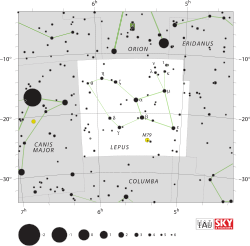Mu Leporis

| |
| Observation data Epoch J2000.0 Equinox J2000.0 | |
|---|---|
| Constellation | Lepus |
| Right ascension | 05h 12m 55.90168s[1] |
| Declination | −16° 12′ 19.6885″[1] |
| Apparent magnitude (V) | 3.259[2] |
| Characteristics | |
| Spectral type | B9 IV:HgMn[3] |
| U−B color index | –0.357[2] |
| B−V color index | –0.096[2] |
| Variable type | Suspected α2 CVn[4] |
| Astrometry | |
| Radial velocity (Rv) | +27.7[5] km/s |
| Proper motion (μ) | RA: +47.09[1] mas/yr Dec.: –16.39[1] mas/yr |
| Parallax (π) | 17.54 ± 0.55[1] mas |
| Distance | 186 ± 6 ly (57 ± 2 pc) |
| Details | |
| Radius | 3.39 ± 0.16[4] R☉ |
| Surface gravity (log g) | 3.85[6] cgs |
| Temperature | 12,800[6] K |
| Metallicity [Fe/H] | –0.05[6] dex |
| Rotational velocity (v sin i) | 16 ± 0.5[4] km/s |
| Other designations | |
Mu Leporis (μ Lep, μ Lep) is a star in the southern constellation of Lepus. The apparent visual magnitude is 3.259,[2] making the star visible to the naked eye at night from the southern hemisphere. Parallax measurements yield an estimated distance of 186 light-years (57 parsecs) from the Earth.[1]
The stellar classification of this star is B9 IV:HgMn,[3] although the ':' indicates an uncertain spectral value. The luminosity class of IV indicates that this is a subgiant that has exhausted the hydrogen at its core and it is in the process of evolving into a giant star. At present it has about 3.4 times the Sun's radius[4] and an effective temperature of 12,800 K in its outer envelope.[6]
Mu Leporis is a suspected Alpha² Canum Venaticorum variable with a period of about two days, although this has not been confirmed. The spectrum of this star shows overabundances of mercury and manganese, as indicated by the HgMn in the stellar class.[4] X-ray emission has been detected coming from a location at an angular separation of 0.93 arcseconds from this star. At the estimated distance of Mu Leporis, this equals a projected distance of 52 Astronomical Units. The source may be a stellar companion: either a star that has not yet reached the main sequence or a small, low-temperature star. The X-ray luminosity of this object is (4.4 ± 0.1) × 10 29 erg s−1.[8]
References
- ↑ 1.0 1.1 1.2 1.3 1.4 1.5 van Leeuwen, F. (November 2007), "Validation of the new Hipparcos reduction", Astronomy and Astrophysics 474 (2): 653–664, arXiv:0708.1752, Bibcode:2007A&A...474..653V, doi:10.1051/0004-6361:20078357
- ↑ 2.0 2.1 2.2 2.3 Gutierrez-Moreno, Adelina et al. (1966). "A System of photometric standards" 1. Publicaciones Universidad de Chile, Department de Astronomy. pp. 1–17. Bibcode:1966PDAUC...1....1G.
- ↑ 3.0 3.1 Houk, N.; Smith-Moore, M. (1988), Michigan Catalogue of Two-dimensional Spectral Types for the HD Stars, Volume 4, Declinations -26°.0 to -12°.0, Ann Arbor, MI: Department of Astronomy, University of Michigan, Bibcode:1988mcts.book.....H
- ↑ 4.0 4.1 4.2 4.3 4.4 Kochukhov, O. et al. (October 2011), "No magnetic field in the spotted HgMn star μ Leporis", Astronomy & Astrophysics 534: L13, arXiv:1110.0829, Bibcode:2011A&A...534L..13K, doi:10.1051/0004-6361/201117970
- ↑ Wilson, Ralph Elmer (1953). General Catalogue of Stellar Radial Velocities. Washington: Carnegie Institution of Washington. Bibcode:1953QB901.W495.....
- ↑ 6.0 6.1 6.2 6.3 Smith, K. C.; Dworetsky, M. M. (July 1993), "Elemental Abundances in Normal Late B-Stars and Hgmn-Stars from Co-Added IUE Spectra - Part One - Iron Peak Elements", Astronomy and Astrophysics 274 (2): 335, Bibcode:1993A&A...274..335S
- ↑ "mu. Lep -- Variable Star of alpha2 CVn type", SIMBAD (Centre de Données astronomiques de Strasbourg), retrieved 2012-01-09
- ↑ Behar, Ehud et al. (September 2004), "Resolving X-Ray Sources from B Stars Spectroscopically: The Example of μ Leporis", The Astrophysical Journal 612 (1): L65–L68, arXiv:astro-ph/0407338, Bibcode:2004ApJ...612L..65B, doi:10.1086/424485
External links
- Jim Kaler's Stars, University of Illinois: MU LEP (Mu Leporis)
| ||||||||||||||||||||||||||||||||||